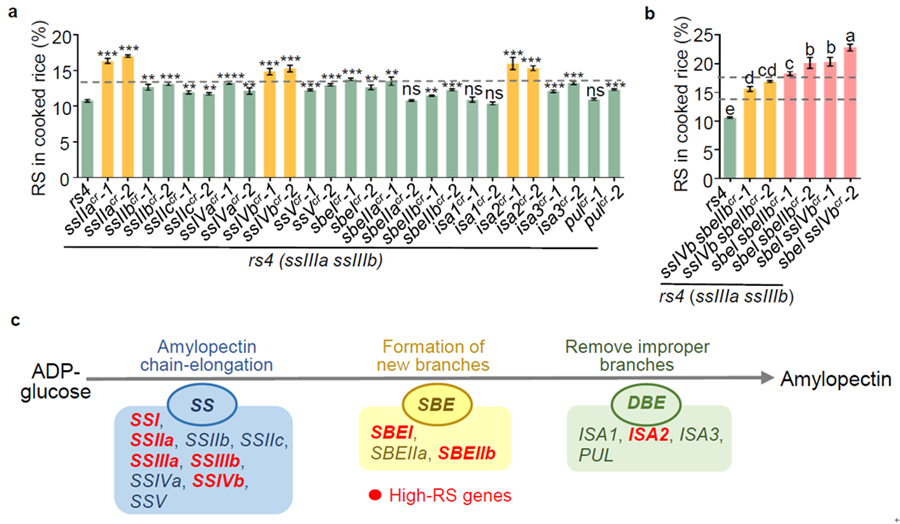Scientists have shown that the mutations of specific amylopectin biosynthetic genes could further increase the resistant starch (RS) contents in the soluble starch synthase IIIa (ssIIIa) ssIIIb background, providing insights into the RS biosynthesis in rice.
This study, conducted by WANG Anqi et al. from Prof. LI Jiayang’s team from the Institute of Genetics and Developmental Biology of the Chinese Academy of Sciences, was published online on November 19th in Plant Biotechnology Journal under the title “Creation of high-resistant starch rice through systematic editing of amylopectin biosynthetic genes in rs4” (DOI:10.1111/pbi.14511).
Obesity, type 2 diabetes, and related complications have become a major threat to global health. Resistant starch, a type of special starch, has shown beneficial effects on diabetes, weight management and inflammatory bowel disease.
Rice is one of the most important staple crops in the world, providing an excellent source of starch. However, most rice cultivars only contain an RS level lower than 2% in cooked rice. Therefore, elucidating the mechanism of RS biosynthesis has important theoretical and practical significance for improving the nutritional value of rice.
Previously, LI Jiayang's team and collaborators discovered that single mutant ssIIIa and double mutant ssIIIa ssIIIb could increase the RS content from 2% to 6% and 10%, respectively (Zhou et al., 2016, Wang et al., 2023). However, the function of other amylopectin biosynthetic genes on RS formation remains largely unknown.
In this study, the researchers used genome editing to conduct a systematic genetic analysis of 14 amylopectin biosynthetic genes in the ssIIIa ssIIIb double mutant background. The mutation of specific amylopectin biosynthetic genes further increased the RS content in the ssIIIa ssIIIb background. Moreover, they found that the quadruple mutants of sbeI sbeIIb ssIIIa ssIIIb and sbeI ssIVb ssIIIa ssIIIb could boost RS levels to more than 18%.
Furthermore, the eating quality of cooked rice and grain yield decreased as RS contents increased, indicating a trade-off between these traits. In these mutants, the ssIIIa ssIIIb mutant demonstrated balanced RS and grain yield.
In conclusion, our study shed light on RS biosynthesis by identifying a number of amylopectin biosynthetic genes and developing practical ways for breeding high-RS rice varieties with balanced performance.
Figure: Creation of high-resistant starch rice by systematic
editing of amylopectin biosynthetic genes in the ssIIIa ssIIIb background (Image by IGDB)
Contact:
Dr. YU Hong
Institute of Genetics and Developmental Biology, Chinese Academy of Sciences
hyu@genetics.ac.cn
 Figure: Creation of high-resistant starch rice by systematicediting of amylopectin biosynthetic genes in the ssIIIa ssIIIb background (Image by IGDB)Contact:Dr. YU HongInstitute of Genetics and Developmental Biology, Chinese Academy of Scienceshyu@genetics.ac.cn
Figure: Creation of high-resistant starch rice by systematicediting of amylopectin biosynthetic genes in the ssIIIa ssIIIb background (Image by IGDB)Contact:Dr. YU HongInstitute of Genetics and Developmental Biology, Chinese Academy of Scienceshyu@genetics.ac.cn CAS
CAS
 中文
中文




.png)
